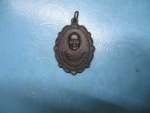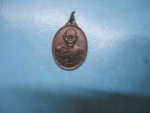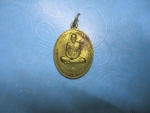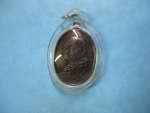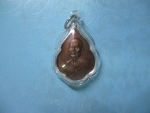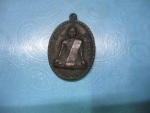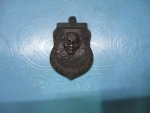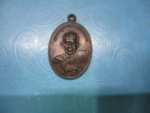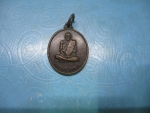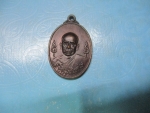หมวดหมู่สินค้า
พระเครื่องกระดูก/งา งานแกะสลักเรือโบราณ

สภาพสินค้า :
สินค้ามือสอง
ราคา :
0.00
บาท
วันที่เริ่ม :
15 ก.พ. 2553 15:19:34
วันที่อัพเดท :
14 ก.ย. 2553 17:23:06
ip :
125.25.49.xx
ข้อมูลร้าน
ร้าน :
ชื่อผู้ขาย :
-
จังหวัด :
-
จำนวนสินค้า :
0 ชิ้น
คนเข้าชม :
-
อัพเดทร้าน :
-
เปิดร้าน :
-

รายละเอียดสินค้า
*นี่คืองานแกะที่มีความเป็นมายาวนานครับงานลักษณะนี้เรียกว่า Scrimshaw เป็นงานของชาวเรือโดยแท้ (สำหรับชิ้นนี้ มีอิทธิพลผสมผสานระหว่าง ชาว อลาสก้าและชาวญี่ปุ่น)มีประวัติชิ้นงานแบบนี้ว่า เกิดจากการที่พวกเขาออกทะเลไปนานๆก็จะเหงา จึงหาอะไรมาทำฆ่าเวลา วิธีหนึ่งก็คือนำวัสดุที่หาได้จากท้องทะเล เช่นกระดูกปลา เขี้ยวปลาขนาดใหญ่ งาหรือเขี้ยวตัว วอลลัส มาแกะสลักรูปต่างๆที่เขาเชื่อถือว่าจะนำมาซึ่งโชคลางที่ดี ส่วนเนื้อหาของงานส่วนใหญ่จะเน้นไปที่ลายเส่นต่างๆเช่น ลายแผนที่ ลายที่เป็นรูปร่างหน้าตาฯลฯ(ดูรายละเอียดเพิ่มจากเอกสารที่เผยแพร่ในต่างประเทศ) เมื่องานเสร็จพวกเขาก็นำติดตัวเข้าฝั่งและต่อมาก็กลายเป็นที่นิยมเสาะหาของนักสะสม และก็มีผู้สืบทอกงานแบบนี้ออกมาอย่างต่อเนื่องดังกล่าว
งานแบบนี้ว่ากันว่ากว่าจะเกิดลวดลายและความคมชัดของลายเส้นต่างๆ เขาต้องใช้เท็คนิคการกัดลายด้วยน้ำกรด คืออาศัยการกัดของกรดให้กินเข้าไปในเนื้องานเพื่อเกิดลวดลายดังว่า ความยากง่ายจึงอยู่ที่การควบคุมปริมาณและความหนักเบาในการฝังลายต่างๆ นั่นเอง ดังนั้นจึงไม่น่าแปลกใจที่ศิลป์นี้ ได้รับความนิยมแพร่หลายและเป็นที่ต้องการของนักสะสมเป็นอย่างมาก
สำหรับชิ้นนี้ก็เป็น Antigue Whale Tooth Scrimshaw ชิ้นงามที่น่าภาคภูมิใจอีกชิ้นครับ
ถ้าท่านหาในเว็ปประมูลชั้นนำของต่างชาติก็จะพบการประมูลงานลักษณะนี้มากมาย ผมมีสะสมอยู่พอสมควรและจะนำมาลงเป็นระยะครับ.
/////
Estimating the Age of Whale Teeth from Natural Dry-Out Cracks
This guide outlines one basic method used to estimate the age of authentic whale teeth. Scrimshaw collectors are always interested in knowing whether a whale tooth is:
Antique (>100-years old); Vintage (50-yo to 100-yo); or Contemporary/Modern (<50-yo).
Other, more complicated factors (NOT discussed here) are involved in narrowing or confirming the age of whale ivory.
All whale teeth have a natural skirt at the base of a tooth, which protects the living nerve root. Young teeth have a blade-thin & knife-sharp skirt edge [image #1]. In contrast, the tooth skirt of teeth from old whales can be short & thick, or nearly non-existent [image #2]. Most antique scrimshawed whale teeth were taken from mature Sperm whales, where as most vintage & modern scrimshawed whale teeth were taken from any Sperm whale within reach of a harpoon gun. It is probable that more teeth were scribed during 1980 through 1982, than in the 100-years prior, and most of these teeth were 8-ounces or less. In all of the following images, note that size differences often reflect age differences.
Any tooth NOT 'in situ' (original mouth location) immediately begins to dry-out. Two symptoms are surface hardening (becoming brittle) and cracking (due surface shrinkage). With age, both characteristics become more pronounced.
For Sperm whale teeth, the surface hardening happens within a few months of removal from the whale. Victorian-era scrimshanders working on fresh teeth could easily use common tools at hand, such as pocket knives & sail needles, on the soft-surfaced teeth. Contemporary scrimshanders use razor-sharp Xacto blades and needle-sharp tungsten scribing tips. Even then, scribed lines on the brittle surface of an aged whale tooth [image #3] are actually a series of linked, minute, shatter-pits, just like scratching glass.
In whale teeth, 'age-cracking' progresses very slowly, and may take decades before becoming apparent. A thin tooth skirt may show age-cracking years before a more stout tooth from the same whale. Using dry-out cracks to determine age is only a guide, and does not take into account environmental conditions prior to evaluation. To counter dry-out cracking, I store all of my scrimshawed whale teeth in a hermetically-sealed glass display case, with a shot-glass of water inside.
Victorian-era scrimshanders cut-off a 1/2-inch (or more) of the skirt edge. This left a blunted, thicker lip, which physically resists dry-out cracking, and allowed the whale tooth to stand, or self-display vertically. On antique whale teeth, these blunted skirt edges often display a 'crazed' cracking pattern [image #4]. Losing a 1/2-inch on a 7-inch tooth is nearly negligible, but modern scrimshanders most often scribe 4-inch to 6-inch teeth, and purposely do not shorten teeth for any reason.
Traditionally,
a whale tooth skirt with NO dry-out cracks is considered to be <25-yo [image #1];
a whale tooth skirt with one, maybe two small, fine, dry-out cracks is <50-yo [image #5];
a whale tooth skirt with several dry-out cracks is 50-yo to 100-yo [image #6];
a whale tooth with multiple dry-out cracks, and/or 'crazing' is >100-yo [image #4 & image #7].
Dry-out age cracking can also be observed across the median line between the hard core-tip (Dentine) aka Golden Crown, and the outer layer (Cementum) [image #8]. The line count is roughly the same as for the tooth skirt.
Displaying or storing a whale tooth in an excessively dry environment can cause premature cracking, or accelerate existing age cracks. Once a crack reaches 1/3 to 1/2 length of tooth, it has the very real potential of reaching the tip, and even meeting another crack from the other side, cleaving the tooth in half.
Patina (tooth color) naturally deepens with age, but is also heavily influenced by environmental conditions. A tooth stored in a drawer for 100-years could be just as ivory-white as a new tooth. On the other hand, a 25-year old tooth displayed on the open shelf in the home of a smoker could have deep, rich, brown patina from the absorption of tar from cigarette smoke. A similar color can be obtained (or enhanced) by immersion in tea or coffee. Usually, only in-hand evaluation can reveal false patinas, so a written guide on patina is not as useful as this guide on dry-out cracking. Correctly assessing the age of a whale tooth through properly interpreting both dry-out cracking and patina, depends on accumulated experience as much as knowledge. The more whale teeth you view, the more experience you will acquire. And remember: you can NEVER see too many whale teeth.
นี่ก็เป็นข้อมมูลจากต่างประเทศอีกที่มาหนึ่งครับ.
Home > Library > Miscellaneous > Wikipedia A small collection of ScrimshawFor other uses, see Scrimshaw (disambiguation).
Scrimshaw is the name given to handiwork created by whalers made from the byproducts of harvesting marine mammals. It is most commonly made out of the bones and teeth of Sperm Whales, the baleen of other whales, and the tusks of walruses. It takes the form of elaborate carvings in the form of pictures and lettering on the surface of the bone or tooth, with the engravings highlighted using a pigment, or small sculptures made from the same material. The making of scrimshaw began on whaling ships between 1817 to 1824 on the Pacific Ocean, and survived until the ban on commercial whaling. The practice survives as a hobby and as a trade for commercial artisans. A maker of scrimshaw is known as a scrimshander.[1] Scrimshaw is also a surname.[2]
Contents [hide]
1 History and Materials
2 Gallery
3 Care and Preservation
4 Scrimshaw design
5 Scrimshaw collections
6 Modern Scrimshaw
7 Books and Links
8 References
History and Materials Pair of Scrimshawed Walrus Tusks depicting a sailor and a lady. Rhode Island or Connecticut, circa 1900 Closeup of sailor Closeup of LadyScrimshaw is derived from the practice of sailors on whaling ships creating common tools, where the byproducts of whales were readily available. The term originally referred to the making of these tools, only later referring to works of art created by whalers in their spare time. Whale bone is ideally suited for the task, as it is easy to work and was very plentiful.
The development of scrimshaw took off after the market for whale teeth, which was sought by Chinese traders for use in the Pacific Islands (for example the Fijian market for tabua), was flooded with teeth after a narrative by an American sailor, Captain David Porter, revealed both the market and the source of the teeth. Around this time is the earliest authenticated pictorial piece of scrimshaw (1817). The tooth was inscribed with the following This is the tooth of a sperm whale that was caught near the Galapagos islands by the crew of the ship Adam [of London], and made 100 barrels of oil in the year 1817.[3]
Other sea animal ivories were also used as alternatives for rarer whale teeth. Walrus tusks, for example, may have been acquired in trade from indigenous walrus hunters.
Scrimshaw essentially was a leisure activity for whalers. Because the work of whaling was very dangerous at the best of times, whalers were unable to work at night. This gave them a great deal more free time than other sailors. A lot of scrimshaw was never signed and a great many of the pieces are anonymous. Early scrimshaw was done with crude sailing needles, and the movement of the ship, as well as the skill of the artist, produced drawings of varying levels of detail and artistry. Originally, candle black, soot or tobacco juice would have been used to bring the etched design into view. Today's artists use finer tools in various sizes, mostly borrowed from the dental industry. Some scrimshanders ink their work with more than one color, and restrained polychromed examples of this art are now popular.
Originating in an era when sperm whales were initially plentiful only to be hunted to near collapse, scrimshaw no longer is an artform utilizing an easily renewable animal resource, but one that is susceptible to contraband. Now, the Endangered Species Act and international conventions restrict the harvest and sale of ivory to try to reverse the scarcity of ivory-bearing animals.
Though there are sources of ivory that are sanctioned and legal, poachers in Africa and other continents where elephants are an endangered species still kill for their ivory, Elephant ivory has been regulated since 1976 by the Convention on International Trade in Endangered Species and selling African ivory has been prohibited since 1989.
19th and 20th century scrimshaw, scrimshaw crafted before 1989 (elephant) or before 1973 (sperm whale ivory, walrus ivory etc.) is legal. It is prohibited after that year for commercial import in the U.S. under the Marine Mammal Protection Act.
Additionally, walrus tusks bearing the Alaska State walrus ivory registration tag, and post-law walrus ivory that has been carved or scrimshawed by a native Alaskan Indian (Eskimo), is legally available.
Finally, any ivory considered ancient, such as 10,000 to 40,000 year old mammoth ivory, is completely unrestricted in its sale or possession.
Scrimshanders and collectors acquire legal whale teeth and marine tusks through estate sales, auctions and antique dealers. To avoid illegal ivory, collectors and artists check provenance and deal only with other established and reputable dealers. Scrimshaw that is found to have been illegally sourced may be seized by customs officials worldwide, dramatically loses value and is very hard to re-sell, as the limited channels through which collectible scrimshaw passes serves as a check on unscrupulous persons. As with any other fine art form, it is usually possible for experienced museums, auction houses or other experts to perceive a fake.
Gallery
Detail on a piece in the Smithsonian Museum collection
Sperm whale jawbone and teeth; part of the collection in the Scrimshaw Museum in Horta (Azores)
Detail on a piece in the Horta (Azores) Scrimshaw Museum
Scrimshaw by Leo J. Meyer
Care and Preservation
Ivory is a fragile medium; many 19th century pieces were preserved because they were kept in a barrel of oil onboard ship. Gary Kiracofe, a scrimshander in Nantucket, MA, advises collectors that if a piece looks dry, one should fill the center of the tooth with unscented baby oil and allow it to remain until as much oil as possible is soaked into the microscopic pores of the ivory. Clear paste wax or high-end car wax will seal the surface after oiling. Bone items are even more fragile (more fibrous and porous) and may be treated the same way - with a light clear mineral oil. Organic oils are inadvisable, as they will eventually hasten discoloration, as on old piano keys subjected to the natural oils in one's hands.
Professional conservators of art and historic artifacts will generally recommend against applying any type of dressing (like oil or wax) to organic objects such as whale ivory. Sensible choices regarding storage and display will preserve whale ivory best: keep out of direct sunlight, handle with cotton gloves or freshly-washed hands, and avoid keeping in places with shifting humidity and temperature. Coating organic objects can induce eventual cracking.
Scrimshaw design
Whale teeth and bones were a highly variable medium, used to produce both practical pieces, such as hand tools, toys and kitchen utensils, and highly decorative pieces, which were purely ornamental. The designs on the pieces varied greatly as well, though they often had whaling scenes on them. For example Herman Melville, in Moby-Dick, refers to 'lively sketches of whales and whaling-scenes, graven by the fishermen themselves on Sperm Whale-teeth, or ladies' busks wrought out of the Right Whale-bone, and other skrimshander articles'.[4] Most engravings were adapted from books and papers.
Scrimshaw collections
Most of the original scrimshaw created by whalers is currently held by museums. Museums with significant collections include:
the Hull Maritime Museum in Kingston upon Hull, England;
the Kendall Whaling Museum which is part of the New Bedford Whaling Museum in New Bedford, Massachusetts;
the Scott Polar Research Institute in Cambridge, England (gallery);
the Scrimshaw Museum in Horta on the island of Faial in the Azores;
the Nantucket Whaling Museum.
Other images of scrimshaw can be found at:
the Museum of New Zealand Te Papa Tongarewa
Privately held original pieces are very valuable, and a great many reproductions (commonly known as 'fakeshaw') exist in the marketplace.[5]
An excellent online collection of Frequently Asked Questions (FAQ) and answers about scrimshaw, ivory, and fakes has been penned by author Jim Stevens. He has also written an online commentary on understanding the Reasons Behind Collector Values.
Modern Scrimshaw Example of modern scrimshaw done in camel bone by artist Sam McDowellWhile scrimshaw is rarely done on whale bone these days, it is still practiced by a few artists. Common modern materials would be micarta and camel bone. Modern scrimshaw typically retains the nautical themes of historical scrimshaw, but can also go well outside of the traditional.
Books and Links
Stevens, Jim: (2008). Scrimshaw Techniques, History, Gallery, Equipment, Types of Ivory, Alternative Materials, Cutting, Sanding, Polishing, Creating Images, Inlays and Basing, Scrimshaw Techniques and Inking, Pub: Schiffer Publishing, ISBN 978-0-7643-2831-2,



